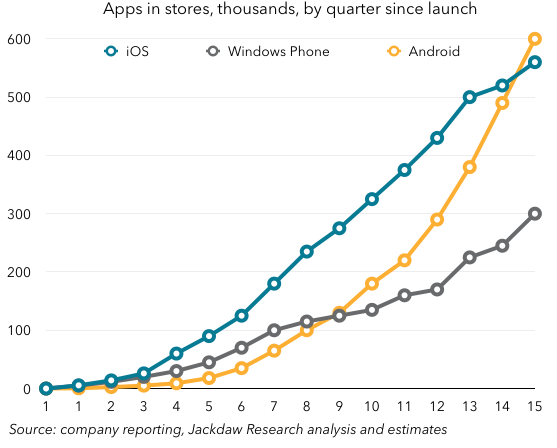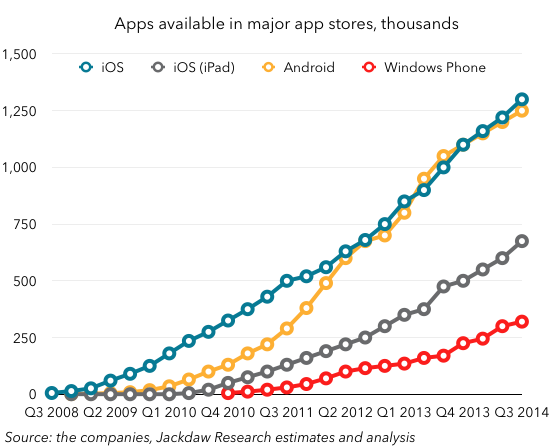Much has been made recently of Microsoft’s shift from a Windows-centric worldview to a cross-platform approach to the development of applications and services. Sometimes, efforts like this are difficult to visualize, so I wanted to take some time to analyze the actual numbers around all this in an attempt to provide a visualization of the degree to which Microsoft has transformed itself. In the process, I’ll highlight a few other points too.
First, the overall numbers
Let’s start with some numbers. These numbers represent the number of apps each of the three major platform companies makes for each of the three main platforms. Specifically, I’m looking here at installable apps, not those that come pre-installed on phones (there is a slight issue here with the fact that Google offers many of its pre-installed apps in the Play store too, but for the sake of simplicity I’ve ignored that). The table below summarizes the current state of affairs (I’ve broken out the mobile and PC operating systems to provide additional granularity):
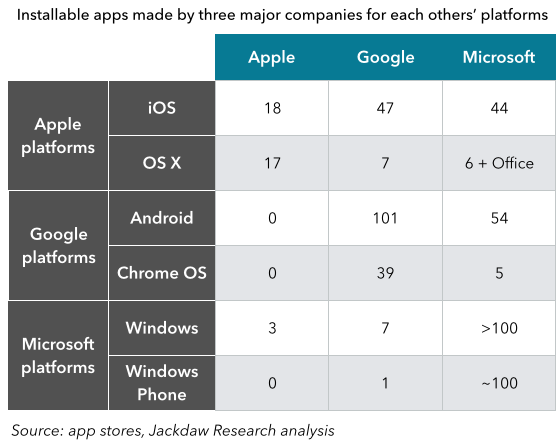 Now, let’s drill into some specific companies.
Now, let’s drill into some specific companies.
Apple – still living by Steve Jobs’ maxim
There’s room for debate about the extent to which Apple still reflects Steve Jobs’ values and policies, and how far it has moved beyond those. One area where it seems to have stuck pretty closely to Steve Jobs’ philosophy is cross-platform development. One of my favorite quotes on this topic comes from Walter Isaacson’s biography of Steve Jobs, in which Jobs described his attitude towards developing an iTunes app for Android thus:
We put iTunes on Windows in order to sell more iPods. But I don’t see an advantage of putting our music app on Android, except to make Android users happy. And I don’t want to make Android users happy.
That perfectly encapsulates Steve Jobs’ philosophy, and Apple’s approach in general, towards cross-platform development: do it when you have to, to enable you to sell devices to people not using Macs, but don’t do it for its own sake. Apple has remained true to that maxim so far under Tim Cook – the chart below has the relevant cells highlighted:
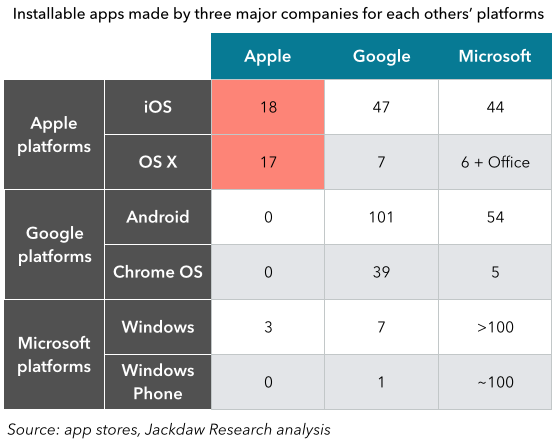 The key conclusion here is that Apple has focused very much on its own platforms, developing a little over a dozen apps for both iOS and OS X beyond those pre-installed on devices, but barely touching the other platforms at all. Where it does so, it’s exclusively to support major Apple services for iPhone and iPad users who also use Windows: iCloud Drive and iTunes are two of the three apps, while QuickTime – necessary for playing Apple-generated video files – is the third. Development of Safari on Windows – arguably a departure from Apple’s usual rules for a time – has been discontinued. It’s also worth noting that, even on its own platforms, Apple isn’t developing dozens of apps – there’s a small, focused number, which reflects another key Apple principle: keeping things simple, and focusing on what it does best.
The key conclusion here is that Apple has focused very much on its own platforms, developing a little over a dozen apps for both iOS and OS X beyond those pre-installed on devices, but barely touching the other platforms at all. Where it does so, it’s exclusively to support major Apple services for iPhone and iPad users who also use Windows: iCloud Drive and iTunes are two of the three apps, while QuickTime – necessary for playing Apple-generated video files – is the third. Development of Safari on Windows – arguably a departure from Apple’s usual rules for a time – has been discontinued. It’s also worth noting that, even on its own platforms, Apple isn’t developing dozens of apps – there’s a small, focused number, which reflects another key Apple principle: keeping things simple, and focusing on what it does best.
The one thing I’ve left out of the chart above is the Beats Music app. I left it out because it was acquired by Apple, rather than developed in-house, and because I suspect that at some point it will be replaced by something integrated with iTunes in the coming months. When that happens, it will be extremely interesting to watch what Apple does from a cross-platform perspective. Will it merely strictly honor its promises at the time of the acquisition and keep the old Beats app around for whoever wants to use it on Android, while developing an iTunes-branded alternative that’s more exclusive in its reach? Or will it use this as an opportunity to reinvent both Beats and iTunes while launching an Apple app on Android for the first time?
Google – developing for the platforms that matter most
Google’s incentives when it comes to cross-platform development are quite different, because its revenue and profits are driven by having the broadest possible audience and not by preferring its own platform. It also has a much more diverse and diffuse set of apps and services it makes available on all platforms though the web. Another favorite quote is this one from Andy Rubin (as quoted by Steven Levy in his book In the Plex), which somewhat summarizes Google’s philosophy:
We don’t monetize the thing we create… We monetize the people that use it. The more people that use our products, the more opportunity we have to advertise to them.
As such, Google develops apps very broadly, not just for its own platforms, but for Apple’s too:
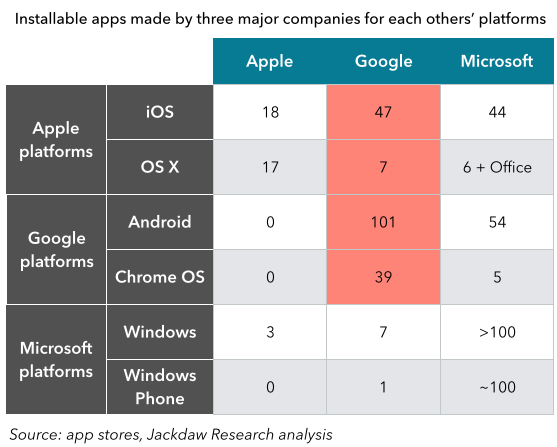
Google actually offers more installable apps for iOS than Apple itself does. In fact, it’s likely that Google is among the most prolific developers for iOS around. All of Google’s core services are now available in some form on iOS, though it hasn’t made the same investment in apps on OS X, largely because these services run perfectly fine in a web browser. Google does make a handful of native apps – such as Picasa, Google Drive and Google Earth – available on both OS X and Windows, but neither platform has been a significant source of investment for Google. Meanwhile, its own Chrome OS has almost 40 apps available, largely because these are simply packaged websites.
Microsoft – broadest cross-platform development
To return to the point that sparked this post, Microsoft clearly has the broadest approach to cross-platform development of the three, developing significant numbers of apps for its own platforms but also those of Google and Apple. Within the last few weeks, Microsoft has announced its intention to add the full version of Office to the list of apps it offers on Android, and last week it released a slew of new MSN branded apps on iOS. The Microsoft column highlighted below really brings out quite how pervasive the company’s presence is on the other two companies’ platforms:
 Microsoft’s count of apps for its own platforms is skewed quite a bit by the large number of Xbox-branded games on Windows and Windows Phone, but there are also huge numbers of legacy enterprise apps on Windows in particular. But it also has almost 50 apps on iOS and over 50 on Android already, and the number looks set to grow even further. It’s worth noting that this hasn’t all happened in the past year: Microsoft has, in fact, been doing a lot of this for quite some time, so it doesn’t just reflect some Nadella epiphany. But the number and nature of those apps available on Apple and Google’s platforms has begun to increase under Nadella, and I think this will continue.
Microsoft’s count of apps for its own platforms is skewed quite a bit by the large number of Xbox-branded games on Windows and Windows Phone, but there are also huge numbers of legacy enterprise apps on Windows in particular. But it also has almost 50 apps on iOS and over 50 on Android already, and the number looks set to grow even further. It’s worth noting that this hasn’t all happened in the past year: Microsoft has, in fact, been doing a lot of this for quite some time, so it doesn’t just reflect some Nadella epiphany. But the number and nature of those apps available on Apple and Google’s platforms has begun to increase under Nadella, and I think this will continue.
Windows – the platform only a mother could love
All of which brings us to the lonely last rows in the table, those representing Microsoft’s two platforms. While Microsoft develops for all three platforms, Google develops only for iOS and its own platforms, and Apple keeps to itself. Windows and Windows Phone are the platforms that get the least love from the other two, with hardly any apps from either Google or Apple:
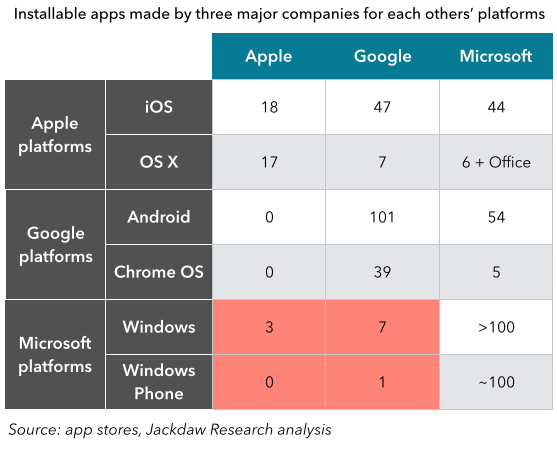 This is particularly remarkable because Google’s objective, as stated above, is to get its services in as many users’ hands as possible. It is likely that the calculus behind Google’s absence from Windows Phone in particular is twofold:
This is particularly remarkable because Google’s objective, as stated above, is to get its services in as many users’ hands as possible. It is likely that the calculus behind Google’s absence from Windows Phone in particular is twofold:
- First, the investment needed to bring key services to Windows Phone is such that the current user base doesn’t justify the time and expense
- Second, there may be a strategic element to withholding Google’s services from its traditional rival, even if Apple seems a more direct threat in many ways.
There may also be an element of leaving Windows Phone to the Microsoft-centric users, though it’s clear from the number of ersatz apps in the Windows Phone store that there’s strong demand for Google apps on the platform. More broadly, though, it’s likely that the first of those two bullet points is the real answer: it simply isn’t worth Google’s time and money to develop for a platform with very small market share and an increasing tendency towards low-end devices. This, of course, mirrors my recent piece on the Windows Phone app gap, and the broader challenge for Windows Phone. And all of this reinforces the need for Microsoft to embrace cross-platform development in the first place: as long as smartphone and tablet users continue to choose platforms owned by the other two companies, users aren’t coming to Microsoft, so Microsoft will have to go where they are, and that’s increasingly on iOS and Android.
